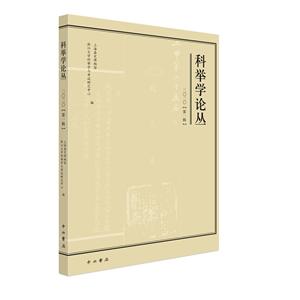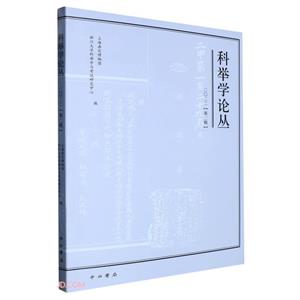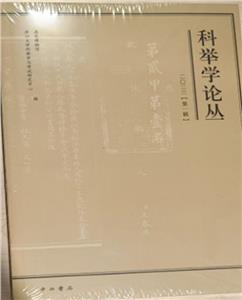
作者:冯用军
页数:304
出版社:科学出版社
出版日期:2020
ISBN:9787030630902
电子书格式:pdf/epub/txt
内容简介
本书在理性辨析和科学界定跨学科研究及其相关核心术语的前提下,从学科构化的新颖角度,认为科举学独特研究对象及其本身的跨学科性决定了跨学科研究方法论的适切性和客观性,而其学科史的多样性、立学标准的多元性和背景学科、学术共同体等的丰富性决定了跨学科研究方法论的必要性和重要性。本书运用跨学科研究方法论探究科举学的独特研究对象及范畴、学科性质和学科体系的规范化问题,有助于从理论上印证科举学作为一门跨学科学问和新兴边缘交叉学科的合理性和可行性,而且,跨学科研究方法论的引入与运用,带来的”双重效应”通过其学科的衍生分化和科际整合也得到了有效验证。进而,通过比较分析了中外新兴边缘交叉学科构建学科制度并取得学科建制的历程和异同,在凝练科举学发展的阶段特征基础上,紧密结合中国特色学科文化场域和行政化学科建设制度的国情,探讨了在大科举学观视野下如何有效借鉴国外新兴边缘交叉学科建设的有益经验,尽快推进其课程体系建设、学科文化系统内涵与形成价值及其合理评价等关键性理论问题。
本书特色
本书是建构”科举学学科大厦”的第五本专著,既可作为教育学门、历史学门、政治学门下相关专业硕士和博士的教材教参,也可作为从事科举研究、考试研究、评价研究、历史研究等的学者和爱好者的重要参考。
目录
目录
序(刘海峰)
第一章 引论 1
第一节 选题缘由与问题提出 2
第二节 国内外研究文献述评 12
第三节 核心术语内涵及其演化 25
第四节 理论分析视角与方法 36
第五节 研究思路与基本架构 45
第二章 跨学科研究的范式分析 48
第一节 跨学科研究的关联概念 49
第二节 跨学科研究的基本内涵 59
第三节 跨学科研究作为方法论 71
第三章 科举学的跨学科性述论 90
第一节 科举学学科史的多样性 90
第二节 科举学立学的多元标准 103
第三节 科举学作为跨学科学问 118
第四章 科举学的基本理论体系 126
第一节 科举学研究对象及范畴 129
第二节 科举学学科性质的分析 140
第三节 科举学学科体系规范化 147
第五章 科举学生长模型与路径 171
第一节 建构科举学人的想象力 173
第二节 科举学学科定位新假说 175
第三节 科举学学科的衍生分化 185
第四节 科举学学科的科际整合 214
第六章 科举学学科设置预研究 223
第一节 科举学立学的经验借鉴 224
第二节 科举学学科发展的阶段 242
第三节 科举学学科基础的分析 253
第四节 科举学学科文化的形成 265
第七章 科举学跨学科研究评价 272
第一节 科举学跨学科评价界定 273
第二节 科举学跨学科评价原则 274
第三节 科举学跨学科评价技术 277
第四节 科举学跨学科评价要素 280
第八章 余论 286
后记 291
Contents
Preface
Chapter 1 Introduction 1
1.Reasons of the Research and the Research Problems 2
2.Literature Summing-up in and Abroad 12
3.Meaning of the Core Concepts and its Revolution 25
4.Perspectives and Methods of the Theory Analysis 36
5.Research Pattern and Basic Framework 45
Chapter 2 Analysis of the Paradigm of the Interdisciplinary Study 48
1.Related Concepts of the Interdisciplinary Study 49
2.Basic Meaning of the Interdisciplinary Study 59
3.Interdisciplinary Study as a Methodology 71
Chapter 3 Review on the Interdisciplinarity of Xin-Kejuxue 90
1.Diversity of the Disciplinary History of Xin-Kejuxue 90
2.Pluralism of the Disciplinary Standard of Xin-Kejuxue 103
3.Xin-Kejuxue as an Interdisciplinary Learning 118
Chapter 4 Basic Theoretical System of Xin-Kejuxue 126
1.Research Object and Categories of Xin-Kejuxue 129
2.Analysis of the Discipline Nature of Xin-Kejuxue 140
3.Normalization of the Disciplinary System of Xin-Kejuxue 147
Chapter 5 Growth Models and Routes of Xin-Kejuxue 171
1.Constructing the Imagination of Researchers of Xin-Kejuxue 173
2.New Hypothesis of the Disciplinary Orientation of Xin-Kejuxue 175
3.Disciplinary Derivation and Differentiation of Xin-Kejuxue 185
4.Interdisciplinary Integration of the Discipline of Xin-Kejuxue 214
Chapter 6 Preliminary Research of the Discipline Setting of Xin-Kejuxue 223
1.Experience Reference of Discipline Construction of Xin-Kejuxue 224
2.Stages of the Disciplinary Development of Xin-Kejuxue 242
3.Analysis of the Discipline Basic of Xin-Kejuxue 253
4.Formation of the Disciplinary Culture of Xin-Kejuxue 265
Chapter 7 Evaluation of the Interdisciplinary Study of Xin-Kejuxue 272
1.Definition of the Evaluation of the Interdisciplinary Study of Xin-Kejuxue 273
2.Principles of the Evaluation of the Interdisciplinary Study of Xin-Kejuxue 274
3.Methods of the Evaluation of the Interdisciplinary Study of Xin-Kejuxue 277
4.Elements of the Evaluation of the Interdisciplinary Study of Xin-Kejuxue 280
Chapter 8 Extra Remarks 286
Postscript 291
序(刘海峰)
第一章 引论 1
第一节 选题缘由与问题提出 2
第二节 国内外研究文献述评 12
第三节 核心术语内涵及其演化 25
第四节 理论分析视角与方法 36
第五节 研究思路与基本架构 45
第二章 跨学科研究的范式分析 48
第一节 跨学科研究的关联概念 49
第二节 跨学科研究的基本内涵 59
第三节 跨学科研究作为方法论 71
第三章 科举学的跨学科性述论 90
第一节 科举学学科史的多样性 90
第二节 科举学立学的多元标准 103
第三节 科举学作为跨学科学问 118
第四章 科举学的基本理论体系 126
第一节 科举学研究对象及范畴 129
第二节 科举学学科性质的分析 140
第三节 科举学学科体系规范化 147
第五章 科举学生长模型与路径 171
第一节 建构科举学人的想象力 173
第二节 科举学学科定位新假说 175
第三节 科举学学科的衍生分化 185
第四节 科举学学科的科际整合 214
第六章 科举学学科设置预研究 223
第一节 科举学立学的经验借鉴 224
第二节 科举学学科发展的阶段 242
第三节 科举学学科基础的分析 253
第四节 科举学学科文化的形成 265
第七章 科举学跨学科研究评价 272
第一节 科举学跨学科评价界定 273
第二节 科举学跨学科评价原则 274
第三节 科举学跨学科评价技术 277
第四节 科举学跨学科评价要素 280
第八章 余论 286
后记 291
Contents
Preface
Chapter 1 Introduction 1
1.Reasons of the Research and the Research Problems 2
2.Literature Summing-up in and Abroad 12
3.Meaning of the Core Concepts and its Revolution 25
4.Perspectives and Methods of the Theory Analysis 36
5.Research Pattern and Basic Framework 45
Chapter 2 Analysis of the Paradigm of the Interdisciplinary Study 48
1.Related Concepts of the Interdisciplinary Study 49
2.Basic Meaning of the Interdisciplinary Study 59
3.Interdisciplinary Study as a Methodology 71
Chapter 3 Review on the Interdisciplinarity of Xin-Kejuxue 90
1.Diversity of the Disciplinary History of Xin-Kejuxue 90
2.Pluralism of the Disciplinary Standard of Xin-Kejuxue 103
3.Xin-Kejuxue as an Interdisciplinary Learning 118
Chapter 4 Basic Theoretical System of Xin-Kejuxue 126
1.Research Object and Categories of Xin-Kejuxue 129
2.Analysis of the Discipline Nature of Xin-Kejuxue 140
3.Normalization of the Disciplinary System of Xin-Kejuxue 147
Chapter 5 Growth Models and Routes of Xin-Kejuxue 171
1.Constructing the Imagination of Researchers of Xin-Kejuxue 173
2.New Hypothesis of the Disciplinary Orientation of Xin-Kejuxue 175
3.Disciplinary Derivation and Differentiation of Xin-Kejuxue 185
4.Interdisciplinary Integration of the Discipline of Xin-Kejuxue 214
Chapter 6 Preliminary Research of the Discipline Setting of Xin-Kejuxue 223
1.Experience Reference of Discipline Construction of Xin-Kejuxue 224
2.Stages of the Disciplinary Development of Xin-Kejuxue 242
3.Analysis of the Discipline Basic of Xin-Kejuxue 253
4.Formation of the Disciplinary Culture of Xin-Kejuxue 265
Chapter 7 Evaluation of the Interdisciplinary Study of Xin-Kejuxue 272
1.Definition of the Evaluation of the Interdisciplinary Study of Xin-Kejuxue 273
2.Principles of the Evaluation of the Interdisciplinary Study of Xin-Kejuxue 274
3.Methods of the Evaluation of the Interdisciplinary Study of Xin-Kejuxue 277
4.Elements of the Evaluation of the Interdisciplinary Study of Xin-Kejuxue 280
Chapter 8 Extra Remarks 286
Postscript 291















